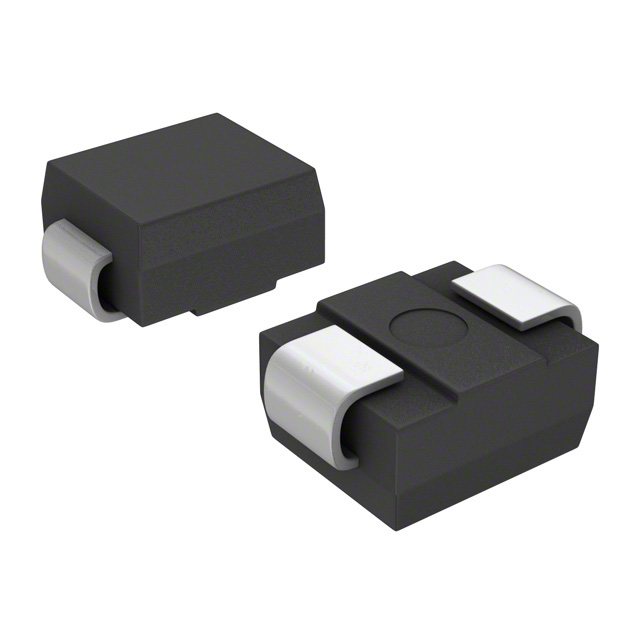Xem thông số kỹ thuật để biết chi tiết sản phẩm.

SMBJ17AHE3/52
Product Overview
- Category: Diode
- Use: Voltage suppression in electronic circuits
- Characteristics: Transient voltage suppressor diode, 600W peak pulse power capability, low clamping voltage, fast response time
- Package: DO-214AA (SMB), SMD/SMT package style
- Essence: Protects sensitive electronic devices from voltage transients
- Packaging/Quantity: Tape & Reel (TR) packaging, 3000 units per reel
Specifications
- Peak Pulse Power: 600W
- Breakdown Voltage: 17V
- Clamping Voltage: 27.4V
- Operating Temperature Range: -55°C to +150°C
- Reverse Standoff Voltage: 17V
- Forward Voltage Drop: 0.6V
- RoHS Compliant: Yes
Detailed Pin Configuration
The SMBJ17AHE3/52 has two pins: 1. Anode (A) 2. Cathode (K)
Functional Features
- Provides protection against voltage transients
- Fast response time ensures minimal damage to protected circuitry
- Low clamping voltage helps in preserving the integrity of sensitive components
Advantages and Disadvantages
Advantages: - High peak pulse power capability - RoHS compliant - Fast response time
Disadvantages: - Relatively low breakdown voltage compared to some alternatives
Working Principles
When a transient voltage spike occurs, the SMBJ17AHE3/52 conducts current to divert the excess energy away from the protected circuit, thus preventing damage to the connected components.
Detailed Application Field Plans
- Used in power supplies
- Telecommunication equipment
- Industrial control systems
- Consumer electronics
Detailed and Complete Alternative Models
- Alternative Model 1: P6KE15CA
- Category: Diode
- Use: Voltage suppression
- Characteristics: 600W peak pulse power, 15V breakdown voltage
- Alternative Model 2: SMAJ17A
- Category: Diode
- Use: Voltage suppression
- Characteristics: 400W peak pulse power, 17V breakdown voltage
This completes the entry for SMBJ17AHE3/52, providing comprehensive information about its category, use, characteristics, specifications, pin configuration, functional features, advantages and disadvantages, working principles, application field plans, and alternative models.
Liệt kê 10 câu hỏi và câu trả lời thường gặp liên quan đến ứng dụng SMBJ17AHE3/52 trong giải pháp kỹ thuật
What is the SMBJ17AHE3/52?
- The SMBJ17AHE3/52 is a surface mount transient voltage suppressor diode designed to protect sensitive electronic components from voltage spikes and transients.
What is the maximum working voltage of the SMBJ17AHE3/52?
- The maximum working voltage of the SMBJ17AHE3/52 is 17 volts.
What is the peak pulse power dissipation of the SMBJ17AHE3/52?
- The peak pulse power dissipation of the SMBJ17AHE3/52 is 600 watts.
What are the typical applications of the SMBJ17AHE3/52?
- The SMBJ17AHE3/52 is commonly used in applications such as telecommunications equipment, industrial controls, consumer electronics, and automotive systems for transient voltage suppression.
What is the clamping voltage of the SMBJ17AHE3/52?
- The clamping voltage of the SMBJ17AHE3/52 is 27.4 volts at 10A.
What is the operating temperature range of the SMBJ17AHE3/52?
- The operating temperature range of the SMBJ17AHE3/52 is -55°C to +150°C.
Is the SMBJ17AHE3/52 RoHS compliant?
- Yes, the SMBJ17AHE3/52 is RoHS compliant, making it suitable for use in environmentally sensitive applications.
What is the package type of the SMBJ17AHE3/52?
- The SMBJ17AHE3/52 is available in a DO-214AA (SMB) package.
Does the SMBJ17AHE3/52 have a low leakage current?
- Yes, the SMBJ17AHE3/52 has a low leakage current, which is beneficial for maintaining system efficiency.
Can the SMBJ17AHE3/52 be used for ESD protection?
- Yes, the SMBJ17AHE3/52 can be used for electrostatic discharge (ESD) protection in various electronic circuits and systems.

